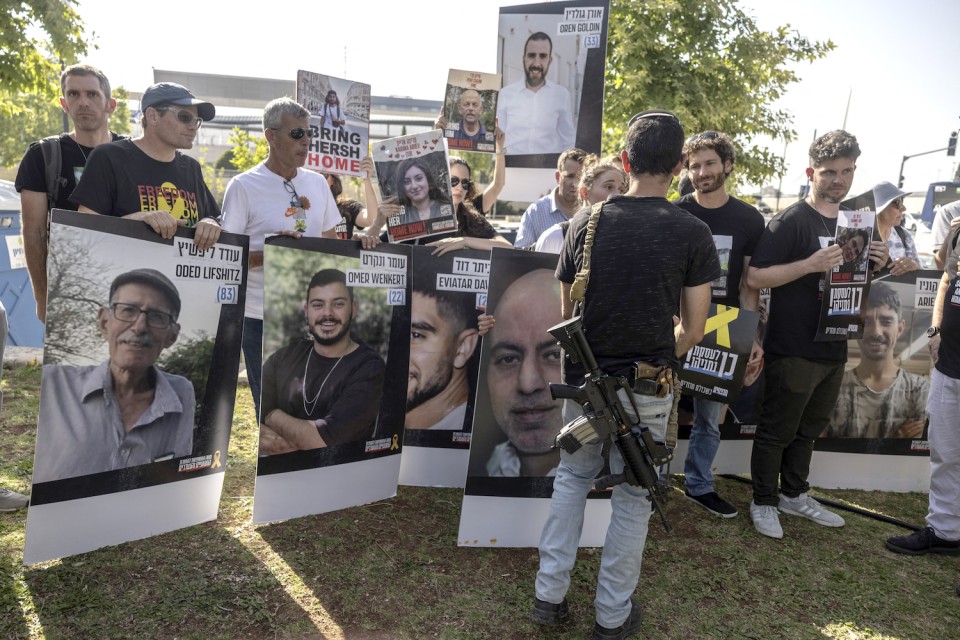
RAFAH, Palestinian Territories, June 3, 2024 (AFP) – Israel on Monday announced the deaths of four captives held in Gaza amid growing doubts and international pressure over a plan for a ceasefire and hostage release deal outlined by US President Joe Biden.
Biden on Friday presented what he labelled an Israeli three-phase plan that would end the bloody conflict, free all hostages and lead to the reconstruction of the devastated Palestinian territory without Hamas in power.
However, Israeli Prime Minister Benjamin Netanyahu’s office stressed that the war sparked by the October 7 attack would continue until all of Israel’s “goals are achieved”, including the destruction of Hamas’s military and governing capabilities.
And on Monday, the White House said Biden told the emir of mediator Qatar that he saw Hamas as “the only obstacle to a complete ceasefire” in Gaza, and urged him to press the group to accept it.
The G7 group of developed countries said in a statement its leaders “fully endorse” the deal pushed by Biden, and called on Hamas to accept it.
Israel’s military announced the deaths in Gaza of four hostages seized on October 7, naming them as Chaim Perry, Yoram Metzger, Amiram Cooper and Nadav Popplewell.
British foreign minister David Cameron said he was “greatly saddened to hear about the death” of Israeli-British Popplewell, adding: “we reiterate our demand for Hamas to send all hostages home”.
All but Popplewell were seen alive in a video released by Hamas in December.
Separately, Israeli military spokesman Rear Admiral Daniel Hagari said: “We assess that the four of them were killed while together in the area of Khan Yunis during our operation there against Hamas.”
Earlier on Monday, the army said it had located in Israel the body of paramedic Dolev Yehud, who had been thought to be a hostage but was killed on October 7.
Israeli media have questioned to what extent Biden’s ceasefire speech and some crucial details were coordinated with Netanyahu’s team, including how long any truce would hold and how many captives would be freed and when.
Hamas on Friday said it viewed Biden’s outline “positively”, but has since made no official comment on the stalled negotiations, while mediators Qatar, Egypt and the United States have not announced any new talks.
– ‘End to suffering’ –
Foreign ministers from Saudi Arabia, the United Arab Emirates, Qatar, Jordan and Egypt issued a statement on Monday backing the latest diplomatic effort.
They “emphasised the importance of dealing seriously and positively with the US president’s proposal”, which could produce “a permanent ceasefire… and an end to the suffering of the people of the Gaza Strip”, the joint statement said.
Israeli government spokesman David Mencer quoted Netanyahu as saying that the outline Biden presented was only “partial”, and that under the plan fighting would only stop temporarily “for the purpose of returning the hostages”.
However, US National Security Advisor Jake Sullivan on Monday said the White House has “seen again over the weekend from Israel a willingness to step forward and do a deal”.
And State Department spokesman Matthew Miller said the proposal was “nearly identical” to one submitted several weeks ago by Hamas and called on its leader, Yahya Sinwar, not to “move the goalposts”.
The fighting showed no sign of easing, with the war that has devastated the coastal territory of 2.4 million people soon to enter its ninth month.
On Monday, Israel’s military said its forces had struck “over 50 targets” over the past day, and Gaza hospitals reported at least 19 fatalities in overnight strikes.
– Heavy fighting –
The war was sparked by Hamas’s October 7 attack, which resulted in the deaths of 1,194 people, mostly civilians, according to an AFP tally based on Israeli official figures.
Militants also took 251 hostages, 120 of whom remain in Gaza, including 41 the army says are dead.
Israel’s retaliatory bombardment and ground offensive have killed at least 36,470 people in Gaza, also mostly civilians, according to data provided by the Hamas-run territory’s health ministry.
Some 55 percent of all structures in the Gaza Strip have been destroyed, damaged or “possibly damaged” since the war erupted, according to the United Nations satellite analysis agency.
Heavy fighting has raged especially in Gaza’s far-southern Rafah area near the Egyptian border, where UN agencies say most civilians have now been displaced once more.
Israel’s military said troops were carrying out “targeted operations in the Rafah area”, and witnesses reported air strikes and shelling.
Gaza’s European hospital said 10 people were killed in an air strike on a house near the main southern city of Khan Yunis, and Al-Aqsa Martyrs hospital reported six dead in a strike on a home in the central Bureij refugee camp.
UN and other aid agencies have warned for months of the looming risk of famine in the besieged territory amid a spiralling humanitarian crisis.
– Political pressure –
Netanyahu, a hawkish veteran leading a fragile hard-right coalition government, is under intense domestic pressure from multiple sides.
Relatives and supporters of hostages have staged mass protests demanding a truce deal — but his far-right coalition allies are threatening to bring down the government if he agrees to that.
In a video message on Monday, Netanyahu insisted Israel would achieve “both tasks” in its war: “the elimination of Hamas” and the return of the captives.
According to Biden, Israel’s three-stage offer would begin with a six-week phase that would see Israeli forces withdraw from all populated areas of Gaza and an initial hostage-prisoner exchange.
Both sides would then negotiate for a lasting ceasefire, with the truce to continue as long as talks are ongoing, Biden said.







